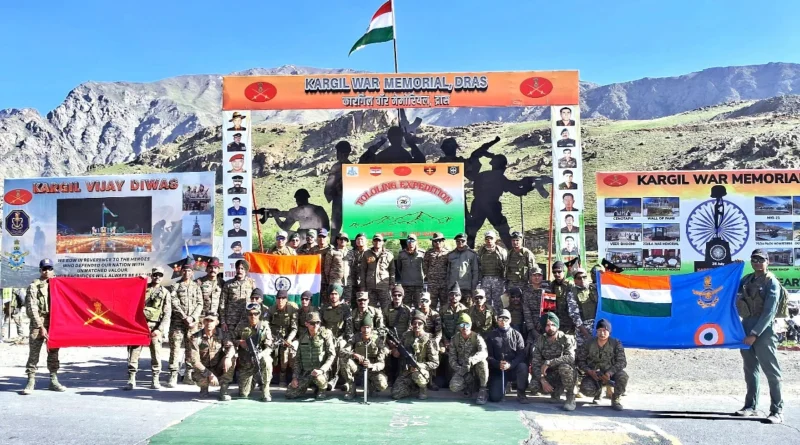Nation Honors the Heroes of Kargil: Remembering Sacrifice and Valor
On Friday, the nation paid tribute to the 545 brave soldiers who laid down their lives while fighting Pakistani infiltrators during the Kargil War of 1999. The Indian Army honored the families of these martyrs at the war memorial here. India has fought many wars throughout its history, but some stand as symbols not only of military valor but also of sacrifice, unity, and determination as a nation. The victory in this war is commemorated every year on Kargil Vijay Diwas on July 26. Besides celebrating a military victory, this day also serves as an opportunity to honor the courageous soldiers who sacrificed their lives in the defense of the nation. On the 26th Kargil Vijay Diwas, the legacy of valor and sacrifice is not just a story from the past but remains vivid in recent events like Operation Sindoor. Over the past 26 years, India has come a long way.
The Kargil War: A Battle Unlike Any Other
The Kargil battle of 1999 was different from any war India had fought before. Pakistani soldiers and militants, taking advantage of the rugged terrain and freezing heights, infiltrated key positions in the Kargil Drass sector. The Indian Army launched a daring operation, Operation Vijay, in one of the most brutal battlegrounds in the world. Peaks like Tololing, Tiger Hill, Gun Hill, and Batra Top became household names in India.
The Kargil Battle
In the summer of 1999, amidst the harsh terrain of Kargil in Ladakh, Indian soldiers fought enemy forces entrenched at over 16,000 feet. Pakistani infiltrators had crossed the Line of Control and made a dangerous claim on Indian land, with the reward being key strategic peaks for India’s security. But the Indian Army launched an audacious counterattack—Operation Vijay—ignoring the treacherous conditions and freezing temperatures. Soldiers climbed steep rocks and engaged in face-to-face combat, a feat that might be unimaginable for most. For nearly three months, stories of bravery and sacrifice emerged as soldiers faced not just enemy fire but also natural calamities.
By July 26, 1999, victory was declared, though it came at a heavy cost. Countless soldiers sacrificed their lives, and their heroism will always be remembered in India. Kargil Vijay Diwas honors their courage, resilience, and unwavering resolve. The day is celebrated across the country, from the eternal flame at the Amar Jawan Jyoti in Delhi to the sacred grounds of the Kargil War Memorial in Drass, where tributes of flowers and offerings are made to those who gave everything for the nation. Despite limited technical support and tough circumstances, Indian soldiers continued to fight for more than two months. The war culminated on July 26, 1999, and is now celebrated as Kargil Vijay Diwas.
Significance of This Year
This year, the significance of Kargil Vijay Diwas has been amplified with the context of Operation Sindoor. In response to a devastating terrorist attack, Indian armed forces launched Operation Sindoor, carrying out a precise, multi-dimensional strike not only against terrorist infrastructure in Pakistan-occupied Kashmir but also deep inside Pakistan itself.
Pakistan attempted to target military and civilian structures on the northern and western borders but failed miserably, eventually requesting a ceasefire. Drones were spotted over Drass, leading to additional air defense deployments. Short-range artillery successfully targeted most of these drones.
The 1999 battle was challenging, as the army often relied on less sophisticated weapons and faced a lack of seamless integration between the services. However, the newly launched Operation Sindoor showcased a transformed Indian military.
Evolution of India’s Military Capabilities
During the Kargil War, the Indian Army used the Bofors FH-77B Howitzer effectively, leveraging its accuracy and range to push back enemies from hilltop positions. Infantry units relied on weapons like INSAS rifles, LMGs, SLRs, and Carl Gustav rocket launchers. The Indian Air Force’s MiG-21 and Mirage 2000 fighter jets provided crucial air cover and precision bombing, particularly during the retaking of strategic locations like Tiger Hill. Despite significant logistical hurdles and limited surveillance and night-vision capabilities, the resilience and innovation of Indian soldiers overcame these challenges.
Today, the Indian Army is technologically advanced. From indigenous communication handsets to state-of-the-art artillery and missile defense systems, the military is better equipped for modern warfare.
Unprecedented Growth in Armament and Modernization
The Indian Army’s armament capacity and modernization have seen unprecedented growth. Indigenous platforms like the Dhanush and ATAGS (Advanced Towed Artillery Gun System) howitzers, soon to be inducted, have replaced traditional artillery, offering greater range and precision. Infantry units are now equipped with modern assault rifles like the SIG716 and AK-203, along with advanced body armor and helmets for better protection. Surveillance has dramatically improved with long-range drone systems, while integrated battlefield management systems facilitate seamless communication. Air defense has been strengthened with indigenous Akash and imported S-400 missile systems, significantly enhancing the capability to counter aerial and drone threats.
The integration of the army, navy, and air force has enabled multi-domain operations, making the armed forces capable of handling hybrid warfare, anti-drone operations, and information warfare. The Indian military now ranks among the most professional forces in the world.
Stay updated with Latest National News in Hindi on Prabhasakshi

